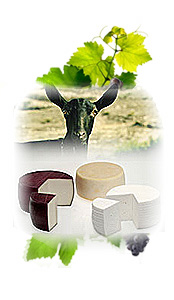C.R.D.O.P. Queso de Murcia y Queso Murcia Al Vino - Contact data
Ubicación y datos de contacto
| C.R.D.O.P. Queso de Murcia y Queso Murcia Al Vino |
| Av. Levante, 53-Entlo. 9 Edif. Géminis 30520 Jumilla (Murcia) Spain |
| ☎: +34‑968783804 🖷: +34‑968783796 |
| w: www.quesosdemurcia.com |
| Regulatory Council of the denomination of origin |
Presentación

Centuries ago, the inventiveness of the murcian shepherds gave to associate the goat cheeses with the product par excellence of the murcian agriculture: wine.
Traditionally, the Region of Murcia has had a major goat cabin, based on breeding and exploitation of the "Goat Murciano-Granadina" race. Numbers historical documents so attest it, particularly the work of the veterinary inspector D. Antonio Panés that in 1922 he published his book "The Murcia goat". This technical document describes how Murcia goat herders elaborated different types of cheeses, using wine as a product base for its cure.
Historically, the exploitation of goat milk in Murcia was still two very different production systems. On the one hand in las vegas, orchards and urban areas, the goat was a domestic animal that is present in most of the farmhouses and countryhouses. Its main function was the supply of liquid milk for family consumption. When the production was sufficient, simple fresh cheeses, using pleitas or simply chiffon cloth and using local products such as the lemon juice or vinegar to curdle the milk were also produced. These cheeses were consumed quickly since it was very difficult to try to cure, because of warm weather and the rudimentary means available at that time for the conservation of food in these areas. The figure of the "goatherd" or "dairy" in the village or neighborhood exploited by a small herd of goats to sell their fresh milk at the door of the houses was also very traditional. We still have numerous villages and neighborhoods of Murcia of a collective historical memory that offers abundant evidence of this fact, which was less regulatory restrictions that were appearing from the Decade of the fifties of the last century.
Traditionally, the Region of Murcia has had a major goat cabin, based on breeding and exploitation of the "Goat Murciano-Granadina" race. Numbers historical documents so attest it, particularly the work of the veterinary inspector D. Antonio Panés that in 1922 he published his book "The Murcia goat". This technical document describes how Murcia goat herders elaborated different types of cheeses, using wine as a product base for its cure.
Historically, the exploitation of goat milk in Murcia was still two very different production systems. On the one hand in las vegas, orchards and urban areas, the goat was a domestic animal that is present in most of the farmhouses and countryhouses. Its main function was the supply of liquid milk for family consumption. When the production was sufficient, simple fresh cheeses, using pleitas or simply chiffon cloth and using local products such as the lemon juice or vinegar to curdle the milk were also produced. These cheeses were consumed quickly since it was very difficult to try to cure, because of warm weather and the rudimentary means available at that time for the conservation of food in these areas. The figure of the "goatherd" or "dairy" in the village or neighborhood exploited by a small herd of goats to sell their fresh milk at the door of the houses was also very traditional. We still have numerous villages and neighborhoods of Murcia of a collective historical memory that offers abundant evidence of this fact, which was less regulatory restrictions that were appearing from the Decade of the fifties of the last century.


